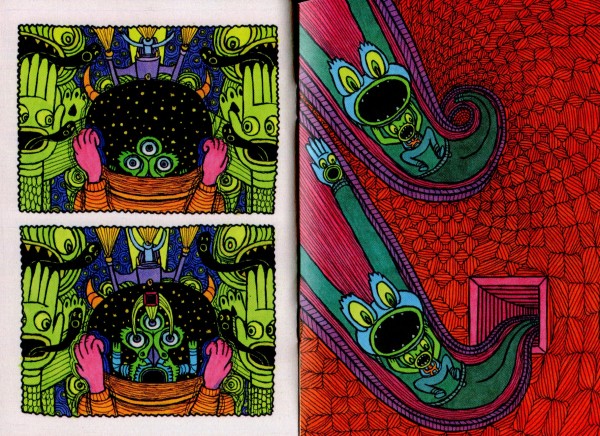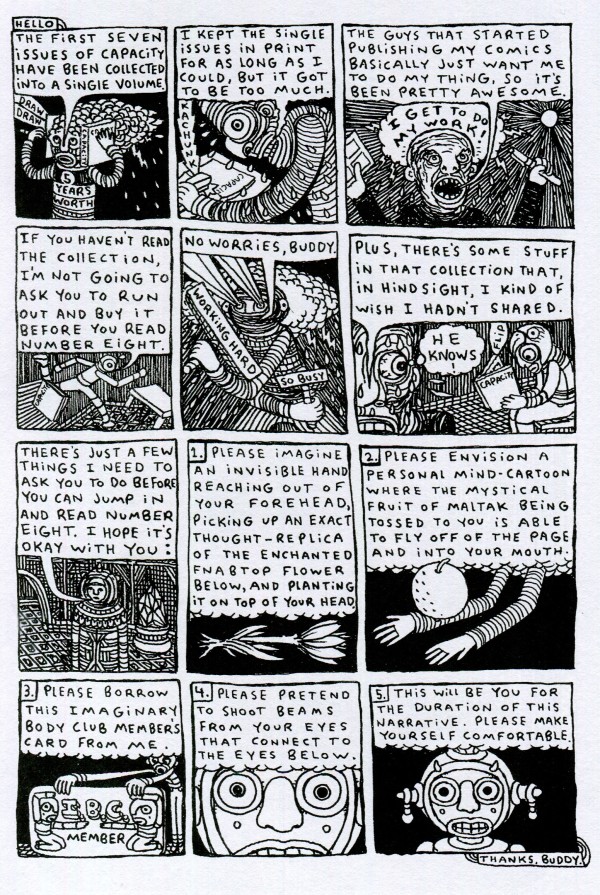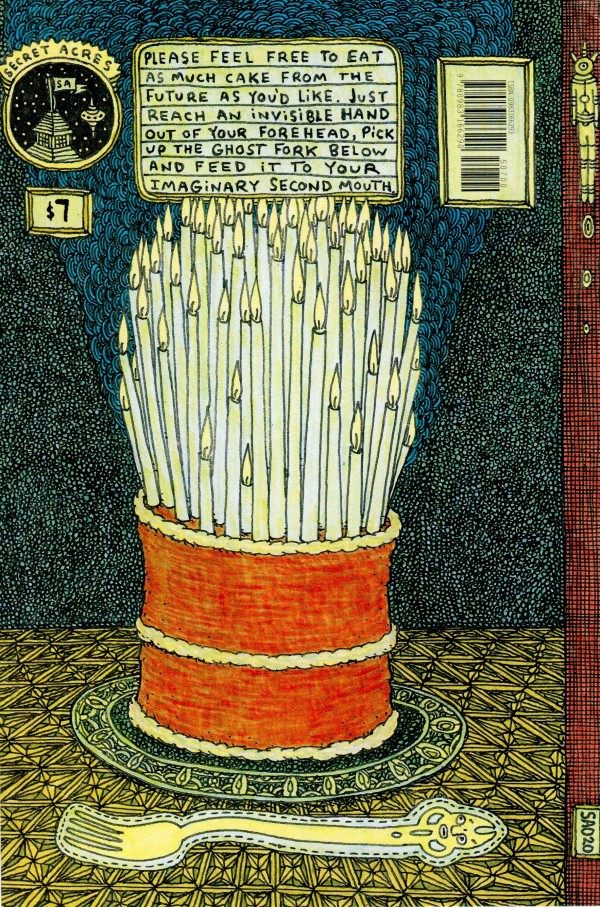What We’re Reading: Buffalo Bill in the Gallery of the Machines; Mystery Mark
My to-read shelf is full of spooky stories I failed to read in October and downer Scandinavian novels—it’s stuff that I don’t dare read in the gray unkindness of winter. Luckily, stuck between a glowering omnibus of a Sigrid Undset tetralogy and 1,000 pages of Hawthorne, I found a holdout of pulpy genre books.
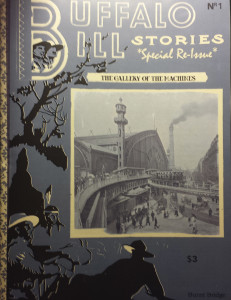 Buffalo Bill in the Gallery of the Machines by Mark Rapacz (self-published)
Buffalo Bill in the Gallery of the Machines by Mark Rapacz (self-published)
The magazine-sized Buffalo Bill is part of Rapacz’s impressive Pulp Curios package, a collection of handsomely printed novellas and magazines. In the Gallery of the Machines is a loyal homage to the Street & Smith dime novels, detailing the waning days of Buffalo Bill’s show and his commitment to the world around him.
Part of Bill’s show is the Patagonian giant, Boneshriek, and most of the short story’s conflict comes from his desire to leave the show due to recurring existential ennui—he isn’t sure where he comes from or where he belongs. Bill is adamant that Boneshriek’s place is in the show, breaking railroad ties and flipping carriages. Bill’s retention of Boneshriek becomes paradoxical, though; while the giant will benefit the Wild West Show, it also benefits Bill’s foil, Thomas Edison, who plans to use Boneshriek to exhibit his new direct current electricity. By keeping Boneshriek, Bill also contributes to the advent of electronic entertainment, displacing the human-powered show that keeps Bill and his show afloat.
Tragedy ensues, but it’s more immediate than anything Bill could have assumed. Bill’s drunken plodding toward the horrific ending makes In the Gallery of the Machines feel like a Greek tragedy; whether Boneshriek stayed or left, it would have been at Bill’s behest, and either way, Bill loses.
Rapacz keeps a careful handle on the dialogue, never slipping into the over-apostrophied renditions of bad Western slang. Buffalo Bill himself code-switches between the overblown speech patterns of the dime novels and the cosmopolitan accent of a tired soldier and world traveler. The narration flirts with the original pulps’ purple proses, but it shows enough restraint for modern readers.
He had seen a cold calf born in the dead of winter upon a field of snow. Saw it come sliding, half-froze, out of the mother. Watched it fall like a log into the bank. No steam rising from it. Its fluids thick and cold and jellied upon it.
If the Buffalo Bill’s electric tragedy isn’t enough, there’s bonus story at the end: “Crookstone,” is a creepy coda to the book. In the vein of Ambrose Bierce or Nathaniel Hawthorne, “Crookstone” is about an abandoned baby who won’t die, a backwoods kaiju, and the unknowable nature of the wild.
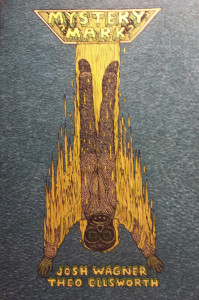 Mystery Mark by Josh Wagner & Theo Ellsworth (self-published)
Mystery Mark by Josh Wagner & Theo Ellsworth (self-published)
Where In the Gallery of the Machines is a modern iteration of a pulp, Mystery Mark is a shadowy echo of New Wave sci-fi. It feels like a Philip K. Dick adaptation of a Bruegel painting that’s been edited down to a blacklisted television pilot.
The book is a back-and-forth game of telephone between Wagner and Ellsworth—Wagner wrote words based on Ellsworth drawings who drew more based on the words and so on. It’s a quick read and is roughly the story of a scared man rediscovering hope, but it all takes place in a world of skeleton spies, spider safecrackers, face replacement surgeries, and a possibly sentient stuffed animal.
Wagner’s prose is straightforward—we’re told exactly what happens and how characters feel. In a naturalistic novel, this would most likely be a detriment, as we expect subtlety and metaphors in literary dramas. In Mystery Mark, though, the world itself is subtle (and sometimes not-so-subtle) metaphor, so the clear prose acts as a sugar coating that helps the oddness go down. Put another way, Ellsworth’s drawings lend the world a strange texture to which Wagner’s writing can play the straight man.
They were the best there ever was—at least that’s what they told each other, and got no argument from anyone. But jobs were scarce these days and competition was fierce. A skeleton had to stay on top of his game.
My one complaint regarding both Mystery Mark and In the Gallery of the Machines is the lack of lady agency. Each book contains a single woman. In Mystery Mark, it’s a snuggly nurse with nary a line of dialogue. Buffalo Bill gives us the legendary Annie Oakley, but we’re repeatedly told how she’s changed since she’s had kids. In the end, Bill narratively emasculates her, taking her gun to use in the fateful denouement. It felt like an aborted case of Chekhov’s gun; we’re shown this sharpshooter but never allowed to see her shoot. While it’s great to see older genres tweaked and reinvigorated, it’s too bad those genres’ gender politics weren’t updated too.
What We’re Reading: Theo Ellsworth

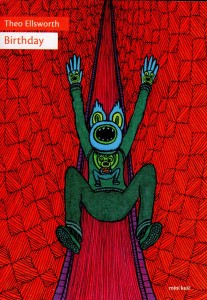 Birthday (mini kuš! #35) and Capacity #8 by Theo Ellsworth (Secret Acres, kuš! komiksi, 2015)
Birthday (mini kuš! #35) and Capacity #8 by Theo Ellsworth (Secret Acres, kuš! komiksi, 2015)
The only text relevant to Theo Ellsworth’s Birthday is on the back cover: “Our hero is insanely nervous. He’s about to undergo an intense psychic initiation known as the Inner-Space Birth Ritual. You’d be nervous, too!” From there, we’re on our own.
Luckily, Ellsworth’s art is filled with patterns of parallel lines and nested ornamentation, making each page feel like a woodcut. The level of detail combined with a complete lack of text encourage one to linger on every panel. The characters feel organically modular: the protagonist’s cloud of anxiety is dispelled to a fish mouth and replaced by a small spaceship-cum-hat. Later, inside a Birth Ritual Helmet, faces flash and change across its starry surface.
In the end, the protagonist is reduced (symbolically?) to a baby, cradled by a massive, smiling creature-structure. The Birth Ritual seems successful, and perhaps the baby has personified and utilized his negative aspects in the process; “process” is the key word here, since the book is more a process than a story. The minimalism is implicitly inviting.
On the other hand, Capacity is explicitly inviting. If Birthday is an organic or ritual process, Capacity is a mechanical one. Ellsworth invites the reader to his 1412th birthday, transporting them through space and time via thought-replicas of fnabtop flowers, a fruit of maltak, and an imaginary body. Dressed in his best wolfman self, Future Ellsworth relates the drastic ways in which the earth will change over the next 1,400-odd years. He explains imaginary hyper-intelligence beans, personal-mind-configuration keys, multi-dimensional time-crystals, and mind-weather starters.
In contrasting the two books, I initially felt that Birthday was like witnessing a miracle whereas Capacity was closer to reading the Bible (or having the Bible explained to you), but there’s something banal in the assumptions behind that comparison. Who wouldn’t choose to witness the miracle?
But I found myself enjoying Capacity a bit more. Reading it felt like being equipped with the tools to understand future miracles and to maybe even make my own.
Does dismantling sets of symbolism reduce their effectiveness? Or can explanation lead to further mysteries?

